West Bali National Park, located at the most north-westerly point of Bali, encompasses the entire Prapat Agung Peninsula and vast areas surrounding the towns of Gilimanuk, Cekik, and Banyuwedang. This national treasure covers an official area of 190 square kilometers within the park’s boundaries and extends into a further 580 square kilometers of protected reserve in the eastern highlands. Collectively, this area represents about ten percent of Bali’s total land area, showcasing the park’s significant contribution to the island’s ecological diversity.
Historical Significance
Established as a beacon of natural preservation, West Bali National Park was first recognized for its ecological importance in 1917 by the council of Bali rulers, who designated it as a nature reserve. It was officially designated as an Indonesian National Park in 1995, underlining its critical role in conservation efforts on the island.
Diverse Landscapes and Habitats
The park’s landscape is a rich tapestry of ecosystems, ranging from rainforests and dry savannas to acacia scrubs, lowland forests, and montane forests in higher areas. It also features dense mangrove forests and protected beaches, alongside the offshore coral reefs and the small island of Menjangan, a diver’s paradise known for its vibrant marine life.
Flora and Fauna: A Biodiversity Hotspot
West Bali National Park is a thriving sanctuary, teeming with an astounding diversity of life. This ecological haven is home to approximately 160 animal species, showcasing the rich tapestry of Bali’s wildlife. Among the mammals, the park provides refuge to an impressive array of species including the stately banteng, graceful rusa deer, elusive Indian muntjac, charismatic Javan lutung, robust wild boar, majestic large flying fox, and the stealthy leopard cat.
The avian world within the park is equally vibrant, with a multitude of bird species gracing its skies and foliage. Notable inhabitants include the majestic crested serpent-eagle, the elegant milky stork, the nocturnal savanna nightjar, the ubiquitous barn swallow, the swift Pacific swallow, the colourful red-rumped swallow, the unique crested treeswift, the vibrant dollarbird, the melodious black-naped oriole, the sociable Java sparrow, the rare lesser adjutant, the assertive long-tailed shrike, the distinctive black racket-tailed treepie, the serene sacred kingfisher, the commanding stork-billed kingfisher, and the cheerful yellow-vented bulbul. Among these, the critically endangered Bali myna holds a place of honor, symbolizing the park’s commitment to conservation.
The reptile population is not to be overlooked, with the critically endangered hawksbill turtle and the imposing water monitor finding sanctuary within its boundaries.
A landmark moment in the park’s conservation history occurred in June 2011, when sixty Bali mynas were reintroduced to their natural habitat, with forty being released from Surabaya Zoo and twenty from Taman Safari Indonesia. This significant event underscores the ongoing efforts to bolster the population of this emblematic species, contributing to the global endeavor to save them from extinction.
Through the concerted efforts of conservationists and the natural bounty of the park itself, West Bali National Park stands as a beacon of biodiversity, playing a critical role in the preservation and appreciation of Indonesia’s natural heritage.
Plant species known to grow in this national park include Pterospermum diversifolium, Antidesma bunius, Lagerstroemia speciosa, Steleochocarpus burahol, Santalum album, Aleurites moluccanus, Sterculia foetida, Schleichera oleosa, Dipterocarpus hasseltii, Garcinia dulcis, Alstonia scholaris, Manilkara kauki, Dalbergia latifolia and Cassia
Climatic Conditions
The park’s climate is typical of Bali and eastern Java, with a warm and humid tropical climate year-round. It experiences a slightly hotter and drier dry season compared to the southern parts of Bali, but maintains a lush and vibrant ecosystem throughout the year.
Accessibility and Activities
Visitors can access the park from the north coast road or the south via Gilimanuk, with park offices located in Cekik and Labuhan Lalang for permits and guided tour arrangements. The park offers a variety of activities, including birdwatching, hiking, snorkeling, and diving, particularly around Menjangan Island, known for its exceptional marine biodiversity.
Conservation and Engagement
With its rich biodiversity and unique ecosystems, West Bali National Park is not only a haven for wildlife but also a vital area for conservation education and sustainable tourism. The park’s management encourages visitors to engage with the natural environment responsibly, contributing to the preservation of this unique part of Bali’s natural heritage.


